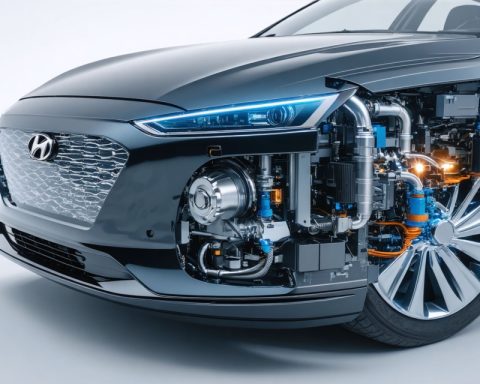- Russian scientists have developed a revolutionary plasma engine, potentially reducing Mars travel time from months to weeks.
- This engine, created by Rosatom’s Troitsk Institute, achieves speeds of up to 100 km/s, significantly outpacing conventional rockets.
- Tests in a vacuum chamber show it can operate at 300 kW and last for 2,400 hours, simulating Mars missions.
- Hydrogen, abundant in space, fuels the engine, enabling less reliance on Earth resources.
- The design enhances durability and reduces thermal stress, promising long-term use.
- Plans are in place to launch a flight-ready engine by 2030, positioning Russia as a leader in space technology.
- Challenges include verifying performance through peer review and addressing power generation demands.
- This technology could lead to rapid interplanetary travel, making quick Martian visits feasible.
A colossal leap in space travel technology could soon transform our journey to the stars. Russian scientists have unveiled a groundbreaking plasma engine capable of slicing the trip to Mars from arduous months to a mere few weeks. Developed by Rosatom’s Troitsk Institute, this marvel uses electromagnetic wizardry to propel spacecraft at astonishing speeds. Imagine a spacecraft accelerating continuously, reaching velocities as high as 100 km/s (360,000 km/h), far surpassing traditional rockets that crawl at 4.5 km/s.
In a compelling display of innovation, the engine undergoes rigorous trials inside a massive vacuum chamber, mimicking the void of space. Operating at an intense 300 kW in pulse-periodic mode, it has already completed a simulated Mars round-trip with a lifespan of 2,400 hours. Once in orbit, this engine could unleash its power, revolutionizing deep-space missions and acting as a cosmic tow truck for both crewed and cargo voyages.
Crucial to this technology is its reliance on hydrogen, the universe’s most abundant element. Utilizing hydrogen allows for the possibility of in-situ resource utilization, promising less dependency on Earth-bound refueling. Moreover, the engine’s efficient design reduces thermal stress, promising endurance over long journeys.
Rosatom’s design promises a tenfold increase in speed compared to existing ion thrusters, potentially catapulting Russia ahead in the global space race. With ambitious plans to launch a flight-ready model by 2030, the future of space travel stands at a tantalizing crossroads.
However, challenges loom. The engine’s full potential awaits peer-reviewed confirmation, and integrating its capabilities into operational spacecraft will demand innovative solutions. Power generation remains another critical hurdle, as sustained missions will likely require the might of a nuclear reactor.
Despite these challenges, Rosatom’s plasma engine could herald an era of rapid interplanetary exploration, transforming the science fiction dream of quick Martian visits into reality.
Revolutionizing Space Travel: The New Plasma Engine That Could Redefine Our Journey to Mars!
How Plasma Engines Work and Their Benefits
How-To Steps & Life Hacks:
1. Understanding Plasma Propulsion:
– Plasma engines operate by using electromagnetic fields to accelerate ionized gas (plasma) to produce thrust. This process involves an electric field that ionizes a gas like hydrogen, which is then expelled at high speeds through a nozzle.
2. Improving Efficiency:
– Maintain optimal engine performance by adjusting electromagnetic fields and gas flow rates. Regular monitoring can maximize thrust while minimizing energy consumption.
3. Sustainable Resource Utilization:
– To utilize in-situ resources, such as extracting hydrogen from Martian or lunar ice, invest in advanced technology to efficiently extract and convert local resources.
Real-World Use Cases and Industry Impact
Real-World Applications:
– Interplanetary Missions: The plasma engine significantly cuts travel time to Mars, making rapid response missions and emergency supply drops more feasible.
– Deep Space Exploration: With its high efficiency and extended operational life, the engine is ideal for missions to the outer planets, providing sustainable thrust over long durations.
Market Forecasts & Industry Trends
Industry Trends:
– Growing Interest in Plasma Propulsion:
– The global space propulsion market is projected to grow due to rising interest in faster interstellar travel. Emerging technologies like plasma engines are at the forefront.
– Competitive Edge:
– With plans to operationalize by 2030, Rosatom’s plasma engine could position Russia as a leader in advanced space propulsion technology.
Reviews & Comparisons
Comparisons:
– Plasma Engine vs. Traditional Rocket Engines:
– Speed: Plasma engines can achieve speeds up to 100 km/s, vastly surpassing traditional chemical rockets.
– Efficiency: Plasma technology offers higher fuel efficiency, reducing the need for large quantities of fuel.
Controversies & Limitations
Potential Challenges:
– Integration with Spacecraft:
– Adapting spacecraft to harness the engine’s capabilities poses significant engineering challenges, requiring innovations in design and material science.
– Power Generation:
– A power-dense source like a nuclear reactor is crucial but presents its own set of challenges in terms of safety and space-readiness compliance.
Features, Specs & Pricing
Key Specifications:
– Thrust Power: Operates at 300 kW in pulse-periodic mode.
– Projected Speed: Capable of reaching speeds up to 100 km/s.
– Endurance: Designed for a lifespan of 2,400 operational hours.
Security & Sustainability
Key Considerations:
– Safety Measures:
– Incorporate robust shielding and fail-safes, especially if nuclear power is used.
– Environmental Impact:
– By reducing dependency on chemical propellants, this technology offers a greener, more sustainable approach to space travel.
Pros & Cons Overview
Pros:
– Dramatically reduces travel time to Mars.
– Higher efficiency and endurance make it suitable for long-duration missions.
Cons:
– Requires advanced safety measures for nuclear integration.
– Long-term reliability and full capability pending further peer-reviewed studies.
Actionable Recommendations
– Invest in R&D:
– To address current challenges, continued research and development into materials, power systems, and integration techniques is essential.
– Collaboration:
– Encourage international collaboration to pool resources and knowledge, accelerating the development and deployment of this cutting-edge technology.
Quick Tips
– Stay Updated:
– Follow developments in plasma propulsion technology to stay informed about advancements and opportunities that may arise.
– Explore Partnerships:
– Engage with aerospace firms specializing in propulsion to explore potential partnerships and innovations.
For further information on advancements in space technology and propulsion systems, explore Rosatom’s work in cutting-edge nuclear and plasma technology at Rosatom.







